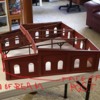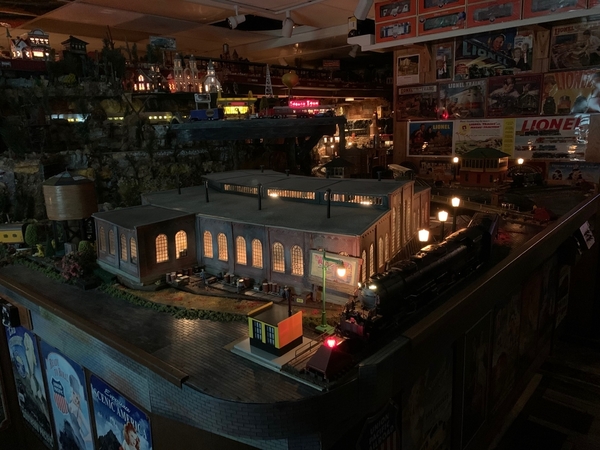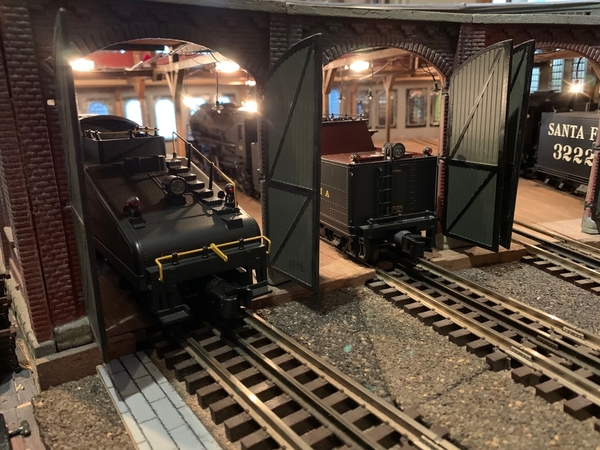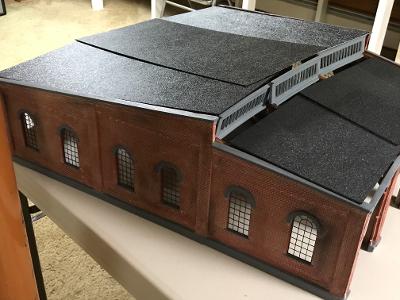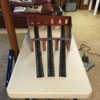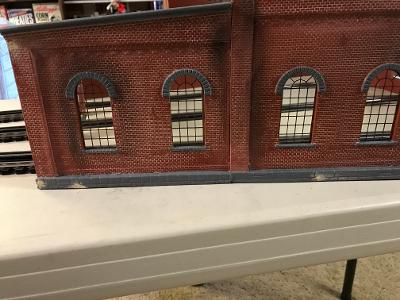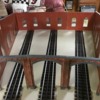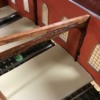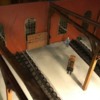Finally, got the wood beams and posts cut to the correct lengths and heights and got lighting installed into the wood beams and was able to get the beams glued into the shell.
I've used two types of lighting for the interior. OGRE green hanging lamp LED's and LED strip lighting. Even with eight (8) OGRE lamps, they are not bright enough to light up the interior of the RH the way I would like it, so I needed to add the strip lighting.
The OGRE lamps were installed by drilling small holes in the wood beams. The lamps have a flexible, plastic rod that can be easily bent to any configuration. On the two outside beams that butt up against the RH sidewalls, there isn't enough room to just hang the lamps from the center of the wood beam because the lamps edges will hit the walls - they have to be spaced out a little further. So I drilled a hole sideways into the beam and then up through the top; cut the rods to length; and bent them into a sideways "z" shape and inserted the rods into the beam so they would go up inside the beam, then out away from the wall and then down. I threaded the wires up through the hole and ran them across the tops of the beams all the way to the rear post and then down through a small hole in the floor and out of the RH shell. There are two lamps per beam and the wires from each were spliced and connected to a small bridge rectifier that comes with the OGRE kit. The bridge rectifier allows 9-16 AC volts to be used for power and each one handles two lamps. If you look closely at the pictures, you can see a small black module near the bottom of each rear post which is the bridge rectifier. For the two center beams, where I didn't need to space the lamps out, they were simply hung straight down using the same basic procedure. Everything was mounted and the wiring run flat across the top of the beams with CA glue and an accelerator.
For the two center beams, I added the LED strip lighting which contains 11 lights each; also runs off 9-12 AC volts; and comes with wire leads already attached. I bought 1/4" Plastruct U-channel beams and cut them to the length of the gap between the two center posts on each beam. The strips are a little longer so I added a second piece of the U-channel along the 45 degree angled wood support for between the post and beam and cut them at an angle where they meet. I then glued the LED strip into the U-channel itself and mounted the U-channel upside down to the bottom of the wood beam and ran the wiring through the post and underneath of the beams, down the rear post and out of the RH shell through a small hole in the floor I had drilled. No bridge rectifier was needed for the LED strips because they have resistors built into the strip.
You can see in one of the pics where all the wiring is hanging down at the rear of the RH and will be threaded through holes in the layout and out to a 14 acv distribution panel off of the accessory posts of my KW. The actual voltage at the panel is 13 acv, so I should be ok.
The wires from each of the lamps and strips were too short to reach the rear post, so additional wire had to be added to lengthen them. All of the wire connections were braided, soldered and shrink-wrapped. I don't want these coming apart. Each beam was also bench tested to make sure all the lamps and strips were working before gluing them in place.
All of the wiring, Plastruct, etc. was painted brown to match the color of the wood beam stain and then dull coated. Unless you look very closely (pic 6) you can't detect the Plastruct channels hiding the LED strips. I considered putting the Plastruct channel on top of the beams to hide the wiring, but thought the exposed wiring looked like it might belong in a structure such as this.
Gluing the wood beams into the structure was a challenge, but my wife sprayed the accelerator as I held each beam in place and that helped immensely. Everything came together nicely and I then cut and fitted the skylights in place as well.
Need to cut the roof sections to size and mount the smokestacks and doors and we're done, except for touch-up work and weathering the roof and floor, but we're on the home stretch.














